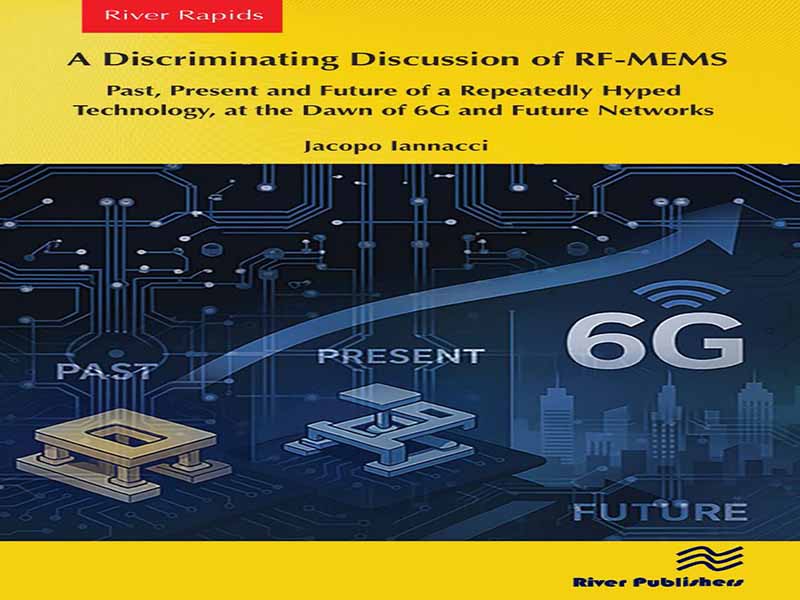- عنوان کتاب: A Discriminating Discussion of RF-MEMS
- نویسنده: Jacopo Iannacci
- حوزه: ارتباطات بیسیم
- سال انتشار: 2025
- تعداد صفحه: 108
- زبان اصلی: انگلیسی
- نوع فایل: pdf
- حجم فایل: 11.0 مگابایت
وقتی 5G (نسل پنجم ارتباطات سیار) فقط یک ایده در حال شکلگیری بود، چیزی حدود 10 سال پیش، ما شروع به آشنایی با بحث خدمات، فناوریها و موارد استفاده کردیم که در نگاه اول به نظر میرسید از فیلمهای علمی تخیلی آمدهاند تا از جامعه علمی. فقط برای اشاره به چند مورد از آنها، پهنای باند موبایل پیشرفته (eMBB) که مثلاً 1 گیگابیت بر ثانیه (گیگابیت در ثانیه) برای هر کاربر را امکانپذیر میکند، و همچنین ارتباطات عظیم از نوع ماشینی (mMTC) و ارتباطات فوق العاده قابل اعتماد با تأخیر کم (URLLC) برای پشتیبانی از ارتباطات خودرو به خودرو (V2V) و رانندگی خودران، در آن زمان به اندازه کافی یک پیشرفت محسوب میشدند. امروزه، ما به داشتن 5G عادت میکنیم و احساس میشود که اختلال مورد انتظار که در دهه گذشته ترسیم شده بود، رخ نداده است. احتمالاً این به دلیل سوگیری انسانی است که توجه زیادی به آنچه هنوز در دست نداریم، بدون اینکه به درستی آنچه را که قبلاً به دست آوردهایم، وزن کنیم. به هر حال، پیشرفتهای 5G، در کنار بهبود یکپارچه خدمات و قابلیتهایی که هر روز به آنها متکی هستیم، در حال تثبیت زمینه مشترکی هستند که 6G (نسل ششم ارتباطات سیار) بر اساس آن گسترش خواهد یافت و از حدود سال 2030 آغاز میشود. در چارچوب اخیر، فناوریهای کلیدی توانمندساز (KET) و موارد استفاده به سطح بعدی منتقل میشوند و سناریوهای کاربردی مانند ارتباطات مبتنی بر هولوگرافی سهبعدی، جراحی از راه دور، متاورس و دوقلوهای دیجیتال، ارتباطات از نوع مغز (BTC) و همچنین افزایش چشمگیر هوش لبهای (EI) را در بر میگیرند، همراه با شاخصهای کلیدی عملکرد (KPI) که مانع Tbps (ترابیت در ثانیه) برای هر کاربر، تأخیر انتها به انتها (E2E) زیر 1 میلیثانیه، قابلیت اطمینان هفت نه (99.99999٪) و غیره را میشکنند. رویکرد رایجی که در مفهومسازی و استانداردسازی 5G و نسلهای قبلی دنبال میشود، با رویکردی که در حال حاضر برای آنچه مربوط به 6G است دنبال میشود، برابر است و عمدتاً از بالا به پایین است. این بدان معناست که ابتدا خدمات و قابلیتهای سطح بالا/کاربر نهایی مفهومسازی میشوند. سپس، استانداردسازی انجام میشود و پس از آن، KPIها و مشخصات باید رعایت شوند، از خدمات (سطح بالا) شروع میشود تا پیچیدگی در زیرساخت شبکه، سیستمهای سختافزار-نرمافزار (HW-SW)، زیرسیستمها و غیره کاهش یابد، تا زمانی که بهینهسازی اجزای سختافزاری با کمترین پیچیدگی حاصل شود. این کتاب یک دیدگاه غیرمتداول از پایین به بالا از یک فناوری برای تولید اجزای سختافزاری با پیچیدگی کم ارائه میدهد که پتانسیل ارتقاء به یک فناوری توانمندساز کلیدی (KET) برای 6G و شبکههای آینده (FN) را دارد. فناوری مورد بحث با مخفف RF-MEMS شناخته میشود که مخفف سیستمهای میکروالکترومکانیکی (MEMS) برای اجزای غیرفعال فرکانس رادیویی (RF) است. این امر امکان ساخت قطعات غیرفعال بسیار کوچک، با کارایی بالا، قابل تنظیم/بازپیکربندی گسترده و چابک در فرکانس را فراهم میکند، که از جمله آنها میتوان به میکروسوئیچهای کم تلفات/با ایزولاسیون بالا، تضعیفکنندههای توان RF چند حالته، خطوط تأخیر و تنظیمکنندههای امپدانس، ماتریسهای سوئیچینگ مرتبه بالا، فیلترهای قابل تنظیم و غیره اشاره کرد. RF-MEMS که برای اولین بار در اواسط دهه 1990 مورد بررسی قرار گرفت، انتظارات بالایی را در مورد جذب بازار ایجاد کرد که سپس به طور سیستماتیک برای حدود یک دهه، از آغاز هزاره تا اوایل دهه 2010، ناامید شده بودند. اندکی بعد، گسترش تلفنهای هوشمند شروع به ایجاد نیازهای بازار کرد که به درستی توسط RF-MEMS برطرف شدند و باعث شد این فناوری حدود 20 سال پس از آغاز به کار وارد بازار انبوه شود. این اثر مخاطبان گستردهای را، چه فنی و چه غیرفنی، در رشتههای مدرن متعدد، شامل میکروالکترونیک، میکروفناوریها، مخابرات، RF و مهندسی مایکروویو، مخاطب قرار میدهد. بحث جامعی در مورد فناوری RF-MEMS در هفت فصل کوتاه ارائه شده است که حوزههای دانش زیر را پوشش میدهد: (1) اطلاعات بنیادی ضروری برای درک RF-MEMS، (2) تاریخچه مختصری از MEMS و RF-MEMS، (3) مروری اساسی بر ادبیات علمی RF-MEMS، (4) بازار RF-MEMS، (5) بحث انتقادی در مورد RF-MEMS و درسهای آموخته شده، (6) میراث مهم کارآفرینی RF-MEMS گذشته و حال، (7) چشماندازهای آینده در سناریوهای نوظهور 6G و شبکههای عصبی مصنوعی.
When 5G (5th generation of mobile communications) was just an idea gaining shape, something like 10 years ago, we started to get familiar with the discussion of services, technologies and use cases, which at first sight looked like they came from science fiction movies rather than from the scientific community. Just to mention a couple of them, enhanced mobile broadband (eMBB) enabling, e.g., 1 Gbps (Gigabit per second) per user, as well as massive machine-type communication (mMTC) and ultra-reliable low-latency communication (URLLC) to support vehicle-to-vehicle (V2V) communication and autonomous driving, were already enough of a breakthrough, back then. Today, we are getting used to having 5G at hand, and it feels like the expected disruption sketched in the past decade has not taken place. It has probably to do with the human bias of paying great attention to what we still do not hold in our hands, without properly weighting what we have already achieved. Anyway, the breakthroughs of 5G, beside seamlessly improving services and functionalities that we rely on every day, are consolidating the common ground upon which 6G (6th generation of mobile communications) will proliferate, starting from (around) 2030. Within the latter context, key enabling technologies (KET) and use cases are pushed to the next level, encompassing application scenario like 3D holography-based communication, remote surgery, metaverse and digital twins, brain-type communication (BTC), as well as a massive increase in edge intelligence (EI), along with key performance indicators (KPIs) breaking the barrier of Tbps (Terabit per second) per user, end-to-end (E2E) below 1 ms latency, seven nines reliability (99.99999 %), and so forth. The common approach followed in the conceptualization and standardization of 5G and of previous generations equals that currently pursued for what concerns 6G, and is predominantly top-down. This means that high-level/enduser services and functionalities are conceptualized at first. Then, standardization takes place, and afterwards KPIs and specifications must be complied with, starting from (high-level) services, to step down in complexity in the network infrastructure, hardware–software (HW-SW) systems, sub-systems, and so on, until the optimization of the lowest-complexity HW components is achieved. This book offers an uncommon bottom-up perspective of a technology for the manufacturing of low-complexity HW components, which bears the potential for elevating to a key enabling technology (KET) of 6G and future networks (FNs). The technology at stake is known by the RF-MEMS acronym, standing for microelectromechanical systems (MEMS) for radio frequency (RF) passive components. It enables the fabrication of highly miniaturized, high-performance, widely tunable/reconfigurable and frequency agile passives, among which are low-loss/high-isolation micro-switches, multi-state RF power attenuators, delay lines and impedance tuners, high-order switching matrices, tunable filters, and so on. Investigated for the first time around the mid-1990s, RF-MEMS boosted elevated expectations around market uptakes that were then systematically disappointed for about one decade, from the turning of the millennium to early 2010s. Shortly later, the spreading of smartphones started to pose market needs that were properly addressed by RF-MEMS, making the technology enter the mass-market about 20 years after inception. This work addresses a broad audience, both technical and non-technical, spread across multiple modern disciplines, encompassing microelectronics, micro-technologies, telecommunications, RF and microwave engineering. A comprehensive discussion of RF-MEMS technology is provided across seven short chapters, covering the following areas of knowledge: (1) essential fundamental information to understand RF-MEMS, (2) a brief history of MEMS and RF-MEMS, (3) an essential review of the RF-MEMS scientific literature, (4) the market of RF-MEMS, (5) a critical discussion of RF-MEMS and of lessons learned, (6) the important legacy of past and present RF-MEMS entrepreneurship, (7) future perspectives in the emerging scenarios of 6G and FNs.
این کتاب را میتوانید از لینک زیر بصورت رایگان دانلود کنید:
Download: A Discriminating Discussion of RF-MEMS




































نظرات کاربران